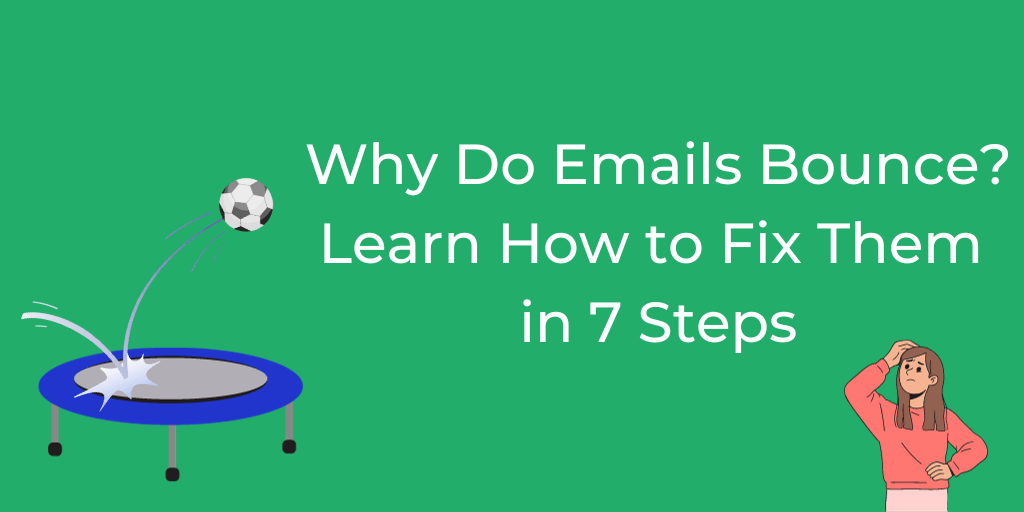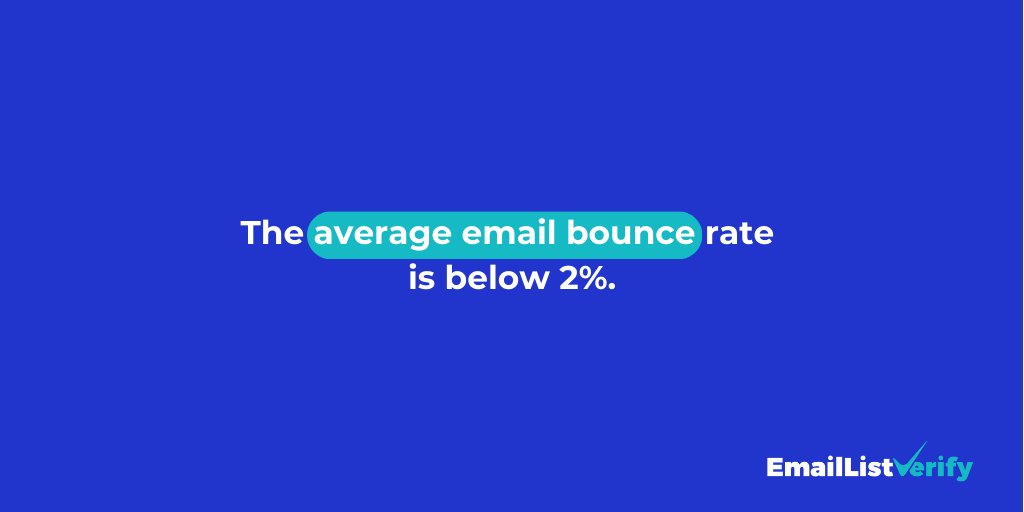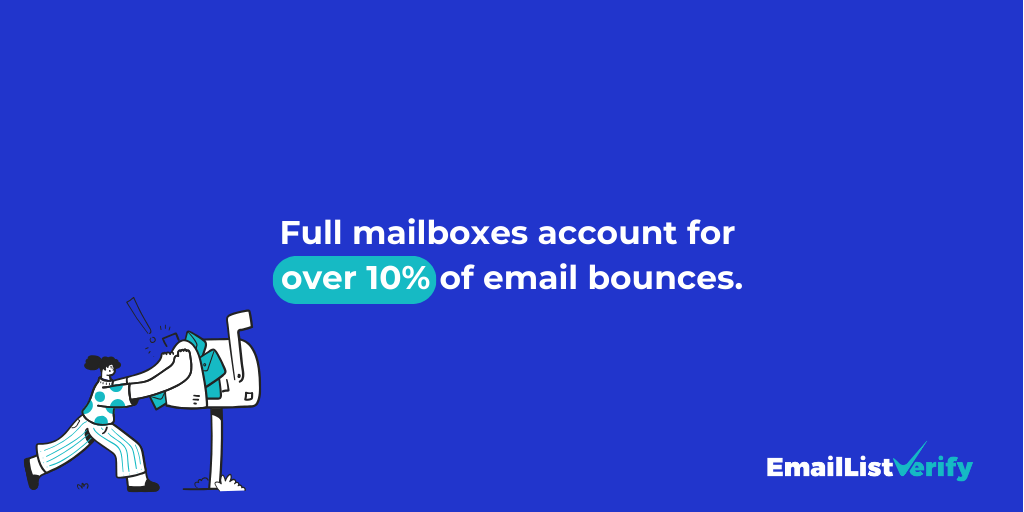Why Do Emails Bounce? Learn How to Fix Them in 7 Steps

Emails bounce primarily due to issues with the recipient’s email address or server. This can occur when an email address is invalid, the recipient’s server is down or temporarily unavailable, or if the mailbox is full.
But before we take a closer look at the issue of bouncing emails, we need to better understand the role that email list management plays in emails reaching their destination.
At its core, email list management is the foundation on which successful email campaigns are built.
It isn’t about just having a list of email addresses — it’s about categorizing email addresses based on criteria like buying habits or engagement levels.
Why does this matter? Because targeted emails are essential to drive up revenue.
With the avalanche of information bombarding users today, it’s never been more important to deliver tailored content.
The math is pretty simple: when you combine relevance with timeliness, you boost engagement.
If you’re wondering what email list management has to do with emails bouncing, think about it this way: with so many emails landing in our mailbox every day, you’re more likely to start marking as spam those that aren’t relevant to you.
And when emails from a company get sent to spam regularly, they might be red-flagged and eventually start bouncing back.
By segmenting contacts and delivering content that caters to your audience’s specific needs and interests, you substantially increase your chances of engaging the recipient every time.

Benefits of email list management
Proper email list management carries many benefits:
Increased ROI
Studies show that marketers who use segmented campaigns see as much as a 760% increase in revenue.
The reason? More relevant content leads to higher engagement, and higher engagement often leads to increased conversions.
Improved Customer Experience
We’ve all been there – receiving an irrelevant email and hitting the ‘unsubscribe’ button. On the other hand, tailored content that addresses specific needs or interests can foster loyalty and encourage repeat business.
In fact, data from Experian shows that personalized emails deliver six times higher transaction rates.
Optimal Resource Utilization
Rather than adopting a ‘one size fits all’ approach, which can be resource-intensive and less effective, targeted campaigns make sure that marketing efforts are directed where they’re most likely to produce results.
At the end of the day, when the content is tailored it doesn’t just capture attention, it also fosters brand loyalty.
What is an Email Bounce?
In its simplest form, an email bounce signifies the return of an email because it could not be delivered to the intended recipient. Think of it as sending a letter and having it returned because the address was incorrect or the recipient had moved.
When you send out an email and it bounces, it essentially means the mail server returned it, signaling it couldn’t be delivered.
There are many reasons an email might bounce, and while we take a closer look into each later on, here’s a brief bullet-point breakdown:
- Non-existent Email Address: The email address is invalid or has been deleted
- Spam Content Detected: The email content triggered spam filters
- Full Mailbox: The recipient’s email box is full and cannot receive new emails
- Domain Issues: The recipient’s domain might be unavailable or has expired
- Server Rejection: Policy reasons might cause the recipient’s server to reject the email
Every bounced email isn’t just a missed opportunity for engagement — it’s also a dent in your sender’s reputation.

High bounce rates, especially if consistent, can tarnish this reputation, because email providers such as Gmail or Outlook keep a close eye on these metrics. A tarnished reputation can mean your future emails are more likely to be marked as spam or blocked, seriously affecting your overall deliverability rates.
No matter what the reason, an email bounce is a symptom of underlying issues in email list management. Addressing these can be the difference between an email campaign that soars and one that falters.
The Two Main Types of Email Bounces
Email bounce issues come in two main types: hard and soft bounces. Understanding these two can be a game-changer for email marketers, as they shed light on the health and hygiene of an email list.
But what’s the actual difference, and why is one so much worse than the other?
Hard Bounce
A hard bounce is the equivalent of hitting a brick wall. It’s a very clear message that the email sent will never be delivered to the intended recipient.
The main reason? An invalid or non-existent email address.
Let’s say you’ve spent hours, maybe even days, curating a marketing campaign. You’re confident about the content, the design is impeccable, and you’ve segmented your audience perfectly. But then, a chunk of your emails bounce back.
The reason? Typos like “gmial.com” instead of “gmail.com” or email addresses that have been shut down. Or maybe the domain itself no longer exists.
The consequences of a high hard bounce rate can be huge. In addition to just the immediate non-delivery of important messages, these bounces can damage your sender reputation, making it increasingly difficult for future emails to reach even valid inboxes.
That’s because ISPs (Internet Service Providers) monitor these metrics closely, and consistent hard bounces can lead to potential blacklisting.
Soft Bounce
Soft bounces are milder email delivery failures compared to hard bounces. They are a temporary setback in email delivery but with the potential for future success.
The reasons can range from full inboxes and out-of-office statuses to temporary server issues.
Addressing soft bounces requires a more refined strategy. Initially, it might be wise to just attempt a re-send. After all, server glitches can be temporary, and a recipient’s mailbox might have space later on.
However, consistent soft bounces from a particular address over an extended period (more than just a few days) might be an indication of a deeper issue.
At this point, you might need to consider these email addresses as hard bounces and remove them from your list.
Top Reasons Why Emails Bounce
Billions of emails zip through the internet every day, ensuring that your message reaches your audience through a series of many components and steps working together. Yet, there are times when a bleep interrupts the process and the email bounces back.
What happened? Here’s a comprehensive look at the top reasons causing these interruptions.
Non-existent Email Addresses
Sending emails to non-existent addresses is one of the main reasons emails bounce. Often, these come from something as simple as typos or outdated lists.
For example, an email addressed to ‘[email protected]’ instead of ‘[email protected]’ will bounce.
Content Triggering Spam Filters
Sophisticated spam filters scrutinize each email. That’s because “in 2022, nearly 49 percent of all e-mails worldwide were identified as spam, up from 46 percent in 2021.” To prevent spam from reaching your main inbox, email providers are becoming more and more strict when it comes to filtering emails.

Too many excessive exclamation marks, overly promotional terms like “BUY NOW!”, or embedding numerous links can raise red flags.
Message Length or Size Exceeding Limits
While storage capacities have increased over the years, there are still size limits. Emails over 10MG are generally considered too large by most ESPs.
Attachments, especially high-resolution images or large files, can cause an email to exceed these limits.
High Frequency or Volume of Emails
Companies sending bulk emails in rapid succession often experience a higher bounce rate.
That’s because ISPs become wary of potential spam activity if they notice a surge of emails coming from one sender in a short span.
Invalid Sender Addresses
Emails from non-existent domains or dubious sources are often flagged.
In addition to these, there are also a number of deeper reasons connected to the tech frameworks that might cause an email to bounce.
For example, the DNS (Domain Name System), the internet’s phonebook, plays an essential role in the delivery of emails. If there’s a misconfiguration in the recipient’s mail server or if the DNS records aren’t set up correctly, the email might bounce.
Think of it as attempting to dial a number from a phonebook, but the listed number is wrong.
It’s also possible server policies can affect email delivery. This happens when the recipient’s email server has strict policies, perhaps related to security, capacity, or even content filtering.
For example, some corporate servers automatically reject emails with attachments for security reasons.
Email deliverability is complex and involves many factors. While some reasons are straightforward, others require a deeper understanding of the complex technology involved.
How to Solve Email Bounce in 7 Steps
With email marketing being so common as a form of business communication, ensuring that emails reach their intended recipient becomes essential.
Here’s a detailed look at some strategies to help you deal with this issue:
1. Address the Reasons for the Bounce
You can’t do anything else until you take a closer look at why emails are bouncing. You can start by analyzing bounce notifications or error messages.
These usually provide specific reasons, whether it’s a full mailbox, a non-existent address, or server issues.
2. Implement Proper Sending Practices
Regularly spacing out your emails instead of sending them in massive blasts can reduce bounce rates. Sending smaller batches, especially to new subscribers or lists, helps in achieving better deliverability.
TIP: You can also use a warmup service like Warmup Inbox, which will interact and engage with your inbox to make sure your emails don’t end up in spam folders and your reputation is restored. As a result, ISPs and mail servers will start viewing your emails as valid and safe.
3. Maintain a Low Bounce Rate
A bounce rate below 2% is considered ideal for email campaigns, no matter the industry.
Prioritizing this metric, especially for hard bounces, is crucial because it affects your sender reputation. Every bounced email should be seen as a missed opportunity and potentially damaging.
4. Regular List Cleaning
Cleaning your email list is essential for engagement. This involves removing unengaged subscribers, correcting typos, and purging non-existent addresses. Remember, it’s about quality, not quantity.
TIP: Use EmailListVerify to clean your email list and reduce your bounces!
Try verifying 100 emails for FREE.
EmailListVerify can quickly and easily get rid of spam traps, hard bounces, and disposable or catch-all emails without breaking the bank.
5. Implement Feedback Loops with ISPs
ISPs like Yahoo, AOL, and Comcast offer feedback loops. By signing up, you’ll be notified when a subscriber marks your email as spam. This real-time feedback is invaluable to help reduce spam and to understand if your campaigns are being well-received.
6. Follow Email Authentication Best Practices
Authenticating your emails makes them more trustworthy to ISPs. Protocols to do this include:
| Protocol | Description |
| SPF (Sender Policy Framework) | Ensures that emails are being sent from a valid server. Studies suggest using SPF can boost deliverability by 10%. |
| DKIM (DomainKeys Identified Mail) | This is like adding a digital signature to your emails. It verifies the email hasn’t been tampered with during transit. |
| DMARC (Domain-based Message Authentication, Reporting, and Conformance) | It’s a policy specifying how the recipient server should handle emails that fail SPF or DKIM checks. Using DMARC can prevent phishing attacks and increase email delivery chances. |
Conclusion
Bouncing emails aren’t just a missed opportunity for a sale or engagement, but they also have long-term effects. They erode the sender’s reputation, reduce the efficacy of future campaigns, and, in the most severe cases, can lead to blacklisting.
Although the differences between soft and hard bounces might not seem that big at first glance, they do require tailored (and very different) strategies.
Hard bounces, largely irreversible, are due to fundamental issues like expired domains or invalid addresses and can’t be fixed. On the other hand, soft bounces are temporary and linked to issues such as full inboxes or server downtimes — but if you don’t address them, they could become a bigger problem over time.
Luckily, there are a number of actionable steps available to mitigate these challenges. Regular list cleaning, using email validation tools, setting up feedback loops with ISPs, and adhering to best practices like SPF, DKIM, and DMARC are not just recommendations — they’re imperatives for any business serious about its email campaigns.
These are essential steps to make sure your emails land where they should.
By being proactive and sticking to best practices, you’re ensuring your emails find their way to the right inboxes.


